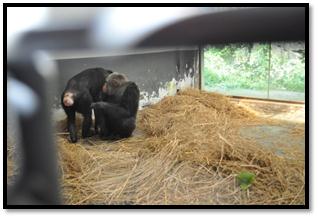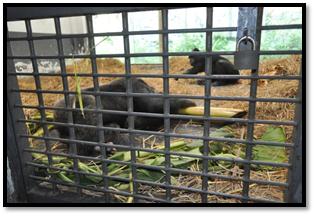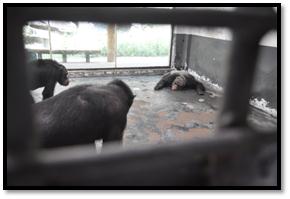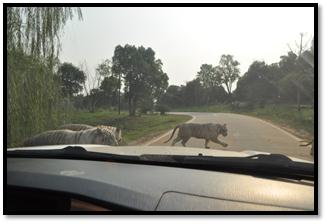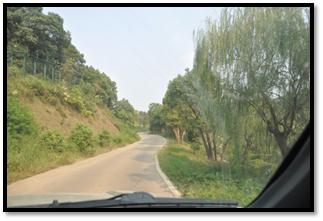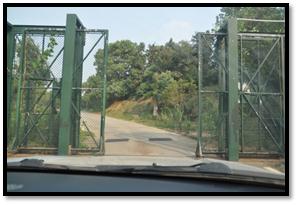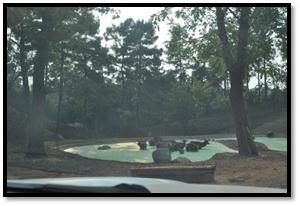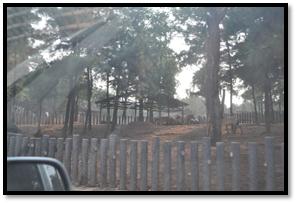|
Changsha Zoo
Goals:
The
purpose of the visit was to introduce 2.1 chimpanzees and to
give recommendations regarding basic husbandry routine and
enrichment for all species.
Chimpanzees
(Pan troglodytes ?)
Subspecies unknown.
Suggestions: Subspecies needs to be determined by DNA testing.
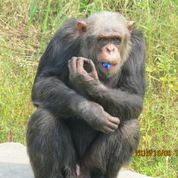 |
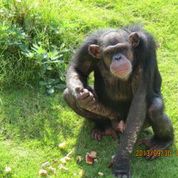 |
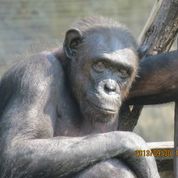 |
|
Kabu
M 14
|
LianLian M 12
|
Sachiko F 26
|
Introduction
Initial
plan was to introduce the two males so they could work out
their differences and there would not be a disagreement
regarding access to female later.
Plan
had changed due to LianLian being considerably smaller, had
unusual behaviors such as loudly screaming for no apparent
reasons or holding his leg while walking. He was also much
intimidated by both chimpanzees. First, he was introduced to
the female and they were left alone to bond. Then, they were
introduced together to Kabu so they could support each
other.
The
plan worked well, to the point when Kabu was rougher than he
should have been, the others chased him around until he was
exhausted. Kabu had calmed down and they are together ever
since.
LianLian
had skin condition and
needed immediate attention. Consultant provided crash course
training program regarding how to spray medication onto
animals using positive enrichment.
Follow up.
Later, a more detailed shaping plan was provided via email.
The skin condition of Lianlian is the same as before.
Treatment is difficult due to public feeding the animals.
Therefor animals are not willing to come inside due to full
stomach; the spray-skin treatment had been suspended for a
while.
The zoo needs to take actions to prevent visitors from
feeding and being able to feed animals especially since Kabu
is already under treatment for a digestive problem. The use
of volunteers would be very helpful for preventing public
feedings.
Chimpanzee
exhibits
The
chimpanzee exhibit was satisfactory in size. Animals were
rotated on exhibit.
The
night houses were large enough, made of concrete, metal and
glass; lacked most furniture and substrate. Hay, paper and
browse was immediately added for nest building and to take
animals off of the unyielding surface.
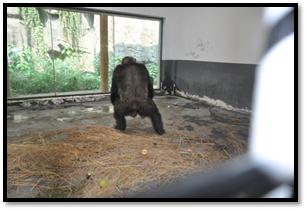 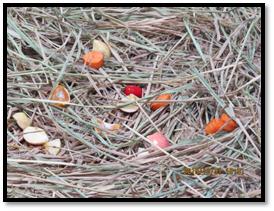
Suggestion: To further improve quality, some flexible furniture
needs to be installed in each night quarter. Animals need
both flexible and permanent structures in order to exhibit
proper motor skills.
All
off exhibit areas should utilize three dimensions by adding
large tree trunks, ropes, fire hoses, hammocks, wooden
shelves, etc., to increase space and provide opportunities
for exercise, exploration and manipulation.
All
cages are to be filled with substrate, browse, logs and
branches. Also since pape ris readily available in China,
all animals should receive newspapers, phone books, paper
bags, etc., in the night houses for nest building.
Follow up:
Changsha zoo has been continuously making enrichment improvements
ever since the consultation providing substrate and
scattered diet.
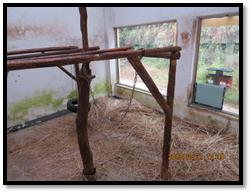 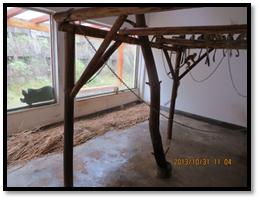
Heated
floor
The
general assumption was the substrate cannot be provided on
heated floor due to being flammable. .
Suggestions:
All animals can have substrate on heated floor. Another option
would be turning off the heat in one night house and provide
deep bedding for nest building while leaving the heat on in
the other and give the animals a choice.
Follow up
Consultant also confirmed with Dr. Steve Ross, SSP coordinator
regarding substrate use on heated floor.
General
propositions:
The
majority of the species were kept in extremely large,
beautiful, safari park style exhibits that any institution
could be proud of.
Night
houses, off exhibit areas and correct substrate use
Since
most animals lived in large exhibits and/or in proper social
groups, our focus was mostly on improving the “off
exhibit” areas. Special attention needs to be paid to all
the night houses and off exhibit holding areas, where
animals spend an average 14-17 hours in concrete/bar cages
or situations where an animal needs to be kept isolated for
any reason.
Suggestions:
Continuing to keep animals off of very hot or very cold,
persistently wet, unyielding surfaces (brick, concrete,
etc.) would be desirable. The use of appropriate substrate
(inside- paper products, hay or straw, etc.; outside-
nonflammable materials such as grass, sand, soil, mulch,
fresh browse, etc.) will make a significant difference not
only in the animals’ health but also in improvement of the
exhibit aesthetics.
Browse
The
zoo has large amount of edible vegetation available on
grounds that could provide fresh, leafy branches (browse).
Suggestions:
Browse should be provided at least every 2-3 days, but if
possible, every day for animals that need them. The zoo can
start planting edible trees, bushes and even crops
inside and outside of exhibits, along visitor pathways and
resting areas that will provide future browsing materials
for growing collection demands. Whether cut by staff or
available by natural damage, fallen vegetation can be used
rather than wasted.
Extending
foraging time
All animals need to be fed
in a way that their foraging time is extended and proper
species-specific behaviors are encouraged. If no one can be
appointed for this position, staff can be scheduled to cut
browse and chop diet on a rotation basis.
Education
The
following power point presentations were given to all staff:
·
Lack
of Substrate Use in Zoos addresses
the easy fix of empty cages and shows how much benefit there
is in the animals’ lives when provided with substrate;
i.e., when they do not have to sit inside of empty concrete
cages. This is probably the most important animal welfare
presentation to give out of the five.
·
Contra-freeloading
at the Phoenix Zoo
presentation talks about making animals work for their food
in similar ways as they would in the wild instead of eating
diet in short period of time from metal dishes or rubber
tubs.
·
Beneficial
Browse gives
guidelines regarding how to develop a zoo-wide browse
program with numerous browse gardens in the middle of the
Sonoran Desert with no money; it also addresses the major
changes that fresh, leafy greens can make in the animals’
lives.
·
Let
Them Be Elephants
addresses the changes we made in our elephants’ lives, how
we helped their behaviors by teaching them how to forage
right and behave like normal females; it also talks about
basic husbandry, enrichment ideas and health care.
Presentations
are available at htrez@thephxzoo.com
Follow up
The accreditation standards and related policies of Association
of Zoos and Aquariums, the Chimpanzee (Pan troglodytes) Care
Manual of Association of Zoos and Aquariums and the South
African National Standards were provided and is being
translated to Chinese in collaboration of the Jane Goodall
Institute and Animals asia.
I
would like to thank the Changsha Zoo’s director and staffs
as well as the Chinese Association of Zoological Gardens (CAZG)
for their incredible hospitality, making me feel so
welcomed.
I
would also like to thank Animalsasia for funding and
organizing this trip and to establish such a wonderful,
working relationship between the Jane Goodall Institute, the
Phoenix Zoo and Changsha Zoo.
|




